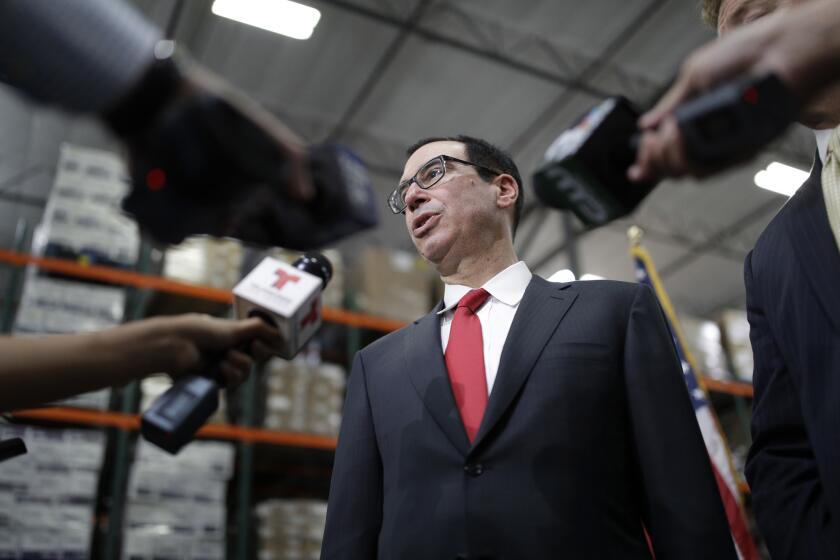Column: Like children playing with matches, GOP again toys with U.S. debt ceiling

- Share via
You might have thought that, what with the pandemic, global warming-driven catastrophes spreading coast to coast, and other urgent matters on their plates, congressional Republicans would set aside the urge for infantile posturing.
You would be wrong.
GOP lawmakers are once again saying they’ll vote against raising the federal debt ceiling, which was suspended for two years the last time it came before them, in 2019.
When I became a man, I put away childish things.
— 1 Corinthians
All of a sudden, they’re wringing their hands about federal deficit spending on the pretense that they’ve never done anything like that and it should only be blamed on Democrats.
So here’s the state of play. Sen. Ron Johnson (R-Wis.) persuaded 45 of his GOP colleagues to sign a pledge refusing to cooperate with Democrats on raising the debt ceiling.
Get the latest from Michael Hiltzik
Commentary on economics and more from a Pulitzer Prize winner.
You may occasionally receive promotional content from the Los Angeles Times.
This is the same Johnson, you may recall, who garnered attention for touting such obviously useless nostrums against COVID-19 as antimalarial drugs and the deworming preparation ivermectin.
In this case, he’s supported by Senate Minority Leader Mitch McConnell (R-Ky.), who also has said his caucus won’t give Democrats a single vote to raise the debt ceiling. Democrats “shouldn’t be expecting Republicans to raise the debt ceiling to accommodate their deficit spending,” Johnson says.
Johnson and McConnell both paid obeisance to the notion that “we should not default on our debt under any circumstances,” as Johnson’s pledge states.
But what if the circumstance were that the Democrats couldn’t muster the votes on their own? Would Johnson’s pledge then become inoperable? Who knows? He and McConnell are plainly counting on the Democrats being the adults in the room.
Republicans, fretting again over the national debt, skate over the role of their tax cuts for the wealthy.
Confidence that Democrats will indeed raise the debt ceiling shouldn’t obscure the absurdity of this recurrent battle over federal spending.
How recurrent?
In 2011, I observed that the debt ceiling had been raised by congressional votes 91 times since 1960, generally without discussion. That included seven times under George W. Bush and three times (by then) under Barack Obama.
That year, Republicans took majority control of the House of Representatives, and the debt ceiling morphed into the raw material of a political stunt.
Before getting more deeply into the consequences of debt-ceiling posturing, let’s examine a few fundamental facts about this artifact — a rule that requires Congress to vote its approval for federal borrowing above a set limit.
First and most important, the debt ceiling was not originally meant as a limit on the Treasury’s authority to issue federal debt, but rather as a way to give it more latitude to borrow.
The debt limit came into being in 1917 when Congress grew weary of having to vote on every proposed bond issuance, which it considered a pain in the neck. So it chose instead to give the Treasury blanket authority to float bonds, subject to a stopgap limitation.
In other words, the limit was never designed to keep Congress from enacting any spending bills or deficit-building tax breaks it wished. Obviously, it has never had that effect, since Congress routinely approves spending that it knows, by simple math, will require more borrowing.
That perennial childishness, a fight over the U.S. debt ceiling, is back.
Raising the debt ceiling does nothing to increase spending; it merely authorizes borrowing for debts already incurred by Congress. In the current case, the need for a vote merely gives Republicans a last-ditch opportunity to carry on about Democratic spending proposals.
Point two: The consequences of failing to lift the debt ceiling once it’s reached would be dire for everyone in the United States because it would mean defaulting on the national debt.
Then-Treasury Secretary Timothy Geithner warned in 2011 that ruining the U.S. government’s unblemished history of always paying its debts would instantly raise its borrowing costs, placing a heavier burden on its budget and slashing the value of government securities held by individuals and pension funds, not to mention investors in other countries.
Government issuance of Social Security checks, Medicare reimbursements to doctors and hospitals, paychecks to military families and vendors would be halted or cut.
The “full faith and credit” of the United States, the preservation of which has helped make the dollar the world’s premier reserve currency at great profit to America and Americans, would be impaired, possibly forever. This could cause “irreparable harm to the American economy,” then-Treasury Secretary Jacob J. Lew warned then-House Speaker John A. Boehner in 2013.
It became fashionable now and then to dismiss these warnings as alarmist, but when the moment of truth arrived, fear of the unknown prevailed and the debt ceiling was raised.
Yet even though the right votes were ultimately taken, the battles themselves produced unhappy consequences.
When the debt ceiling kicked in for only three months in 2003, the government was able to stave off default only through the early redemption of bonds owned by a civil service retirement fund. That cost the fund and its beneficiaries more than $1 billon in lost interest, the Government Accountability Office determined.
The 2011 fight over the debt ceiling resulted in the sequester, an automated austerity regime aimed at suppressing nondefense spending.
The sequester was a gun Congress held to its own head, designed to be so lethal that our lawmakers wouldn’t dare to pull the trigger in the form of required across-the-board budget cuts that were so draconian that Congress would have no option other than find a more measured response. No one told the trigger finger. So the budget cuts went into effect.
The sequester pared gross domestic product by 1.2%. The Congressional Budget Office calculated it would cost as many as 1.6 million jobs over its first two years.
Tens of thousands of 3- and 4-year-olds were barred from Head Start, perpetuating the vicious cycle of poverty and poor educational attainment faced by their families. Unemployment benefits were cut by an average of 15% nationwide. Congressional pay and benefits, naturally, were exempt from those cutbacks.
Every couple of years, with a regularity you can almost set your watch by, Congress flirts with the threat of not raising the federal debt ceiling and toying with a federal default.
The sequester was a case of allowing elected officials “to predicate policy on their own weakness,” as the late Herbert G. Stein, who had been President Nixon’s chief economic advisor, put it in the Wall Street Journal.
So here we are again. The debt ceiling was suspended for two years by a 2019 budget deal, but came back into effect on Aug. 1 at $28.5 trillion. That covers debt held by the public as well as debt held by government agencies, including Social Security.
Without a raise in the ceiling, the Treasury won’t be able to issue new indebtedness. The crunch won’t be immediate, but it looms on the horizon: Various accounting maneuvers will allow the government to keep paying its obligations until sometime this fall.
As is almost always the case, the Republican stance on the debt ceiling depends on mass amnesia. McConnell and other GOP leaders blame Democrats for enacting big spending bills over the last year, but forget that some of them, including pandemic relief bills, passed with bipartisan votes.
Nor do they ever mention one of the biggest budget busters of recent times, the 2017 tax cuts, which passed without Democratic votes and will add more than $1.5 trillion to the deficit over 10 years. Every one of the senators who signed Johnson’s pledge and were in the Senate in 2017 voted for the tax cuts. (Only four GOP senators are missing from the pledge: Lisa Murkowski of Alaska, Susan Collins of Maine, Richard Shelby of Alabama and John Kennedy of Louisiana.)
Those tax cuts overwhelmingly favored corporations and the wealthy, which points to a strategy that Democrats should consider if the GOP stands firm on insisting they manage the debt ceiling issue all by themselves: Roll the 2017 tax cuts all the way back. That should provide enough money to shut the GOP deficit hawks up, at least for a while.
The best option, obviously, is for Democrats to take this opportunity to repeal the debt ceiling entirely. It’s useless except as a partisan device.
Congress should take the words of 1 Corinthians to heart: “When I was a child, I spake as a child, I understood as a child, I thought as a child: but when I became a man, I put away childish things.” Put it away, already.
More to Read
Get the latest from Michael Hiltzik
Commentary on economics and more from a Pulitzer Prize winner.
You may occasionally receive promotional content from the Los Angeles Times.













